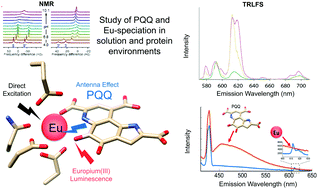Studies of pyrroloquinoline quinone species in solution and in lanthanide-dependent methanol dehydrogenases†
Abstract
Pyrroloquinoline quinone (PQQ) is a redox cofactor in calcium- and lanthanide-dependent alcohol dehydrogenases that has been known and studied for over 40 years. Despite its long history, many questions regarding its fluorescence properties, speciation in solution and in the active site of alcohol dehydrogenase remain open. Here we investigate the effects of pH and temperature on the distribution of different PQQ species (H3PQQ to PQQ3− in addition to water adducts and in complex with lanthanides) with NMR and UV-Vis spectroscopy as well as time-resolved laser-induced fluorescence spectroscopy (TRLFS). Using a europium derivative from a new, recently-discovered class of lanthanide-dependent methanol dehydrogenase (MDH) enzymes, we utilized two techniques to monitor Ln binding to the active sites of these enzymes. Employing TRLFS, we were able to follow Eu(III) binding directly to the active site of MDH using its luminescence and could quantify three Eu(III) states: Eu(III) in the active site of MDH, but also in solution as PQQ-bound Eu(III) and in the aquo-ion form. Additionally, we used the antenna effect to study PQQ and simultaneously Eu(III) in the active site.



 Please wait while we load your content...
Please wait while we load your content...